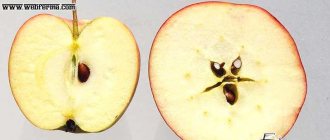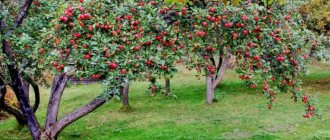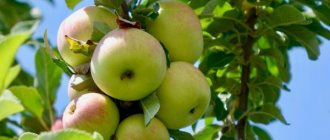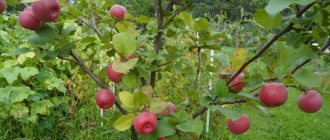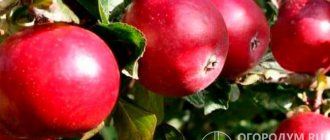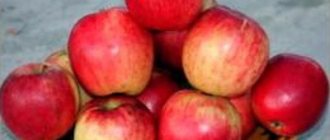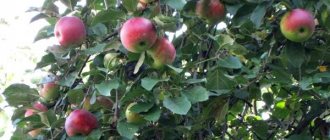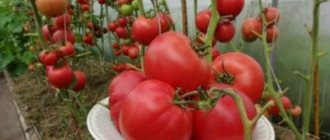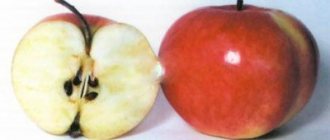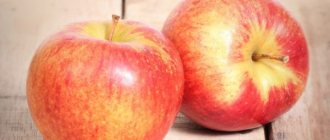The choice of apple tree varieties is amazing in its diversity. Every gardener can choose a fruit crop for his plot after familiarizing himself with its advantages and disadvantages. Malinovka is a summer ripening apple tree. This variety has been known for a very long time; it was found in a place called Suslepa. Therefore, it is also called Suislep or Raspberry Oberland.
Malinovka apple variety.
additional characteristics
The Malinovka variety has many qualities that a gardener needs to consider when choosing a tree to plant on his site.
Advantages and disadvantages
The variety has positive and negative sides, which must be understood for the purity of the experiment.
The advantages are:
- beautiful appearance of apples;
- sweet and sour, juicy fruits.
The disadvantage of the apple tree is considered to be a small harvest. The shelf life of fruits is very short, which, however, is typical for summer representatives.
Tree height
The height depends on the type of Malinovka apple tree; on a dwarf rootstock it grows less. On average it ranges from 3 to 5 meters.
Appearance of an apple tree.
Crown width
The Suislepskoye apple tree has a spherical crown, densely covered with leaves; it can be up to 3.5-4 meters in diameter.
Productivity
The Malinovka apple tree variety produces average yields, producing its first fruits in the third year after planting. And full fruiting occurs in 6-8 years, and it can produce up to 50 kg of apples from one tree. As apple trees age, they stop producing crops every year.
Tasting assessment
Apples with white flesh, juicy, with a sweet and sour taste, tasters rated their dessert taste at 4.5 points.
Features of wintering
The Suislepskoye apple tree variety has average winter hardiness. To protect the tree from frost, in regions with harsh winters it is necessary to use agricultural techniques. This includes mandatory autumn feeding of the plant, insulation of trunks and tree trunk circles.
Apple tree in winter.
Disease resistance
Disease resistance of Malinka depends on weather conditions. During the rainy season, it can be affected by scab, fruit rot and powdery mildew. It is very important for gardeners not to miss the period of plant infection and to carry out treatment on time.
Apple tree Malinovka (Suislepskoe)
Malinovka apple tree, other names: Suislep, Suislep, Suisleper - this is an early summer variety.
The tree is medium in size , the crown is dense and spherical. The branches are raised, dark in color.
The shoots are thick, brown with a reddish tint.
The leaves are medium to large in size, round in shape, dark green in color with jagged edges.
The fruits of the Malinovka (Suislepskoe) variety are flattened, with a very beautiful bright integumentary color.
Medium-sized fruits weighing from 70 to 150 grams . The shape of apples is not one-dimensional, but most often it is round with slight flattening, has ribs, and is conical in the upper part. The fruits can be diversified.
Ripe Robin fruit on a branch.
The main color is from greenish to yellow-green, the outer color is in the form of red stripes, reminiscent of strokes on a pink background.
The skin of the fruit is thin, smooth, and has a waxy coating. The pulp is bright white, pink veins may be present, fine-grained, juicy, and has a sweet and sour taste.
Features of planting and care
Malinovka apple tree seedlings should be straight, the bark should be smooth, and the root system should be well developed. Such plants will take root well and will continue to develop well.
Landing rules
For planting, choose a well-lit place with fertile soil; it should not be close to the roots of groundwater.
Landing dates
The seedlings are planted in the spring, before the buds open, and in the fall, after the leaves fall, but a month before frost.
The timing of planting depends on the characteristics of the root system.
It is recommended to plant seedlings with an open root system in the spring, in late March - early April, and with a closed root system - in the fall, in late September - early October.
Diagram of the distances of apple trees from each other.
Technology
The hole for planting apple trees is prepared 3-4 weeks before planting:
- The distance between trees should be 4 meters, and between rows - 5 meters. It is undesirable for other trees to grow between apple trees.
- In the selected area, they dig a hole 80 cm deep and 100 cm in diameter, and drainage is made from sand and crushed stone at the bottom. A mixture is prepared from fertile soil and humus and poured onto the bottom, driving a stake into the middle.
- The tree is lowered into the hole, the roots are straightened and sprinkled with the prepared mixture, lightly compacted and covered with soil, and a hole is formed around the trunk for watering.
- When planting, it is important that the root collar remains 5-7 cm above the ground surface. Water the tree generously and mulch the tree trunk circle.
The technology for planting a seedling is shown in the video.
Growing and agricultural technology
There are no special requirements for growing the Malinovka apple tree. Following the usual measures will give good results:
- spring pruning and damage treatment;
- preventive treatments against diseases and pests;
- in the absence of rain, trees need to be watered additionally;
- spring and autumn fertilizing;
- preparation for winter depending on the region of growth.
These agrotechnical measures will help keep the apple tree healthy.
Pruning and crown formation
To ensure good access to light and remove diseased, dry and damaged branches, pruning is carried out in the spring. In autumn, branches damaged during fruiting are removed.
The tree is formed in the second year after planting; it is done in such a way that the central shoot is located above the skeletal branches, which should grow far enough from each other.
Tree grafting
By grafting, breeders obtained a new variety of apple tree, Yuzhnoe, from the Malinovka and Delicious varieties. The robin is suitable for grafting and creating new varieties.
Grafting an apple tree in spring.
From the known methods of grafting, each gardener chooses the method he likes. Which varieties to choose for the scion and rootstock depends on what result the gardener wants to get in the end.
The following methods are very popular:
- for the bark;
- into the cleft;
- in the butt;
- budding.
One of the grafting methods can be seen in the photo.
Pollinator varieties
The Malinovka variety is self-sterile, and varieties with the same period of flowering and fruit ripening are suitable for pollination. Papirovka and Moscow Grushevka, according to many gardeners, are suitable as pollinators.
Ripening and fruiting
In different subspecies of the Malinovka apple tree, ripening and fruiting differ in terms of timing.
Beginning of fruiting
Typically, Malinovka begins to bear fruit in the 5th-6th year of cultivation.
Apple trees on a dwarf rootstock begin to bear fruit early - at 3-4 years.
Flowering period
Apple trees bloom in the second half of May. The flowering period depends on weather conditions.
Blooming apple tree.
Deadlines
The timing of fruit ripening depends on the region: in the southern regions it is the end of July - the beginning of August, in the northwestern regions - at the beginning of September. Different subspecies have slightly different maturation times.
Maturation stage
When ripe, apples are greenish-yellow with bright red stripes and barely noticeable green subcutaneous dots. The pulp is snow-white, juicy, aromatic.
Fruit weight is from 80 to 130 g.
They ripen unevenly on the branches, so the fruit may fall off.
Storage and collection of fruits
The skin of apples is very delicate, so they can be damaged during picking and transportation.
The collected fruits are stored for no more than 3 weeks.
Reviews
Valeria
I tried apples from my grandmother in the village and fell in love - despite the fact that Malinovka is small in size, it has a wonderful taste. The tender pulp literally melts in your mouth, very tasty! Juicy, aromatic, although not stored for long. I decided to plant it for myself, I’m waiting for the third year - the tree is not bearing fruit yet, but I hope that in a couple of years there will be results.
Grisha
I bought a plot of land, and there was an apple tree on it. Only six months later I accidentally found out what kind of variety it was, it turned out to be Malinovka. The tree is great for the garden - it provides shade and also produces delicious apples. I wouldn’t recommend planting it specifically - the variety is old, but there are modern ones that are much more convenient in every sense. This one is only good if you already have a tree - then yes, it’s worth taking care of it.
My grandmother has been growing a robin for probably forty years now. I can’t say that the tree itself is very good - the harvest is sometimes good, sometimes average, it varies. Moreover, this does not particularly depend on the weather or care - the tree actually lives its own life. But the apples themselves are excellent - tasty, sweet, beautiful and look appetizing.
Subspecies and options
The Malinovka apple tree comes in several subspecies. They differ from each other in growth, appearance, timing of fruiting and ripening.
Decorative
The decorative Malinovka apple tree is distinguished by its high growth - from 4 to 8 meters, the crown is round or wide-pyramidal. It is also grown in bush form. The crown of the tree is covered with large dark green oval leaves. The flowers are large, white or pink, and open in May. The fruits of this apple tree are small, red when ripe, suitable for making juices and compotes. This variety is distinguished by its high winter hardiness.
Decorative variety of apple tree.
Red-leaved
According to its characteristics, this apple tree is similar to the decorative one, but its peculiarity is the red color of the leaves. This hybrid is more resistant to diseases that affect Malinovka and is unpretentious to growing conditions.
Red leaf apple tree.
Columnar
The columnar apple tree has a main trunk, which is overgrown with shortened fruit twigs, and fruits appear on them. Such trees are planted in areas where there is not enough space for large trees. It is much easier to care for and harvest from such trees than from tall ones.
Apple trees on columnar rootstock.
Rizhskaya
The fruits of this variety are sweet in taste and can be stored fresh for a long time; after ripening, they do not fall off the tree. Riga apples are medium-sized, dark red in color with white flesh. Ripen in September. It is resistant to diseases and low temperatures.
Apple tree variety Rizhskaya Malinovka.
Description of the Malinovka variety
Apple trees of this variety are the pride of any gardener.
Apple trees
are low, with a rounded crown.
The shoots are quite large, brown in color, and lightly pubescent.
The leaves are large, round in shape, green in color.
The leaf blade is wrinkled and curved.
The edges of the plate are jagged.
Inflorescences are medium size, white.
The fruits are medium size, round in shape.
The color of the apple is green; as it ripens, a red blush appears. The skin is medium thick, smooth.
The saucer is shallow, the funnel is shallow. Open type seed chambers.
The pulp is white, sweet and sour in taste.
Growing in regions
The Malinovka apple tree takes root well in different regions; when growing, you need to learn the peculiarities of care and agricultural technology in different climates.
Moscow region and Leningrad region
These regions have cold winters and the Malinovka apple tree is suitable for them. It is important to follow the basic rules of growing in these regions so that the plant is not damaged by frost.
In central Russia
In this region, the Malinovka apple tree takes root well and bears fruit in private plots and industrial farms. It is also planted for decorative purposes.
In North-West Russia
This region has harsh winters, so it is important to prepare the tree. In the fall, cover the apple tree with spruce branches and insulate the free circle with straw or sawdust.
In Belarus
The Suislepskoye or Malinovka variety got its name from the area where it was found. The climates of Belarus and Estonia are similar, so in this region the apple tree grows without any special agricultural techniques.

